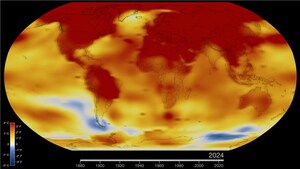HAMPTON, Va., May 31, 2018 /PRNewswire-USNewswire/ -- A NASA instrument that will measure ozone and other key pollutants over North America is seeking proposals for hosting services.
The Tropospheric Emissions: Monitoring of Pollution (TEMPO) instrument will make observations from a geostationary vantage point, about 22,000 miles above Earth's equator, flying on a commercial satellite. TEMPO will be installed on the Earth-facing portion of the host satellite, allowing for an unobstructed view to collect measurements.
To accomplish this, TEMPO has partnered with the U.S. Air Force's Space and Missile Systems Center in El Segundo, California, and will employ their Hosted Payload Solutions (HoPS) contract. Proposals have been requested from the 11 commercial companies associated with the HoPS contract. The offerors will be submitting their proposals to provide satellite integration, launch services, and ground operations by mid-July. A selection will be made in the late 2018 to early 2019 timeframe.
"As the TEMPO instrument nears completion and full space flight qualification, we are excited about this important step required to obtain hosting services and lay the operational framework for TEMPO's critical air quality measurements," said TEMPO Project Manager Stephen Hall at NASA's Langley Research Center in Hampton, Virginia.
TEMPO is led by Hall and Principal Investigator Kelly Chance at the Smithsonian Astrophysical Observatory in Cambridge, Massachusetts.
The TEMPO instrument recently completed a successful vibration test at Ball Aerospace and Technologies Corp. in Boulder, Colorado. This major instrument milestone verifies that TEMPO will survive launch and is one of three different environmental tests that are required for space flight qualification.
TEMPO is the first instrument to be awarded by NASA's Earth System Science Pathfinder Program in the Earth Venture Instrument (EV-I) Class Series. The data collected from TEMPO will revolutionize air quality forecasting and emission control strategies by providing satellite air quality information several times per day.
For more information about Langley Research Center, visit:
SOURCE NASA
Related Links
WANT YOUR COMPANY'S NEWS FEATURED ON PRNEWSWIRE.COM?
Newsrooms &
Influencers
Digital Media
Outlets
Journalists
Opted In






Share this article